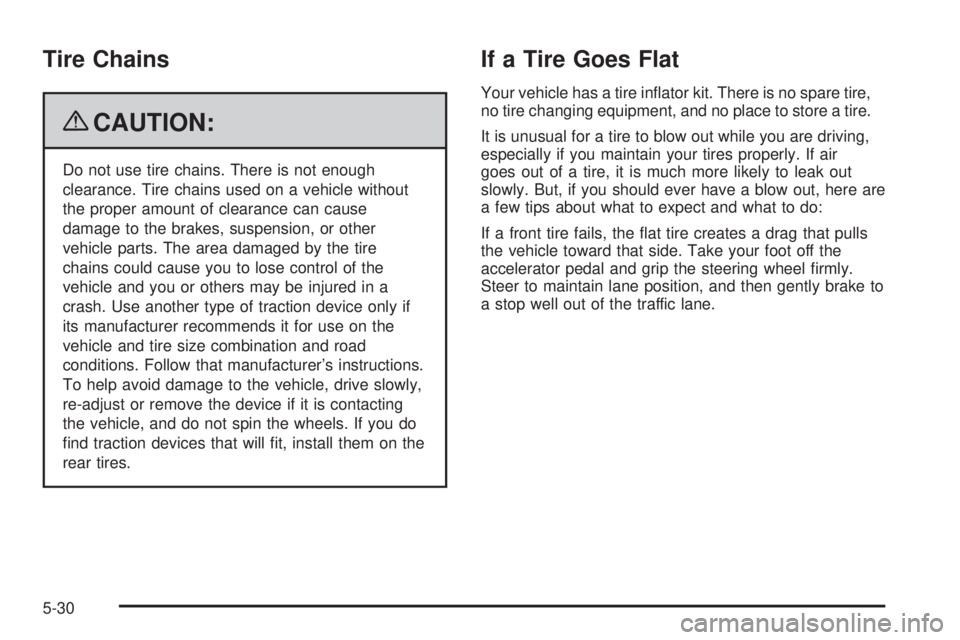Page 64 of 94

You have two minutes to match the first tire/wheel
position, and five minutes overall to match all four
tire/wheel positions. If it takes longer than two minutes,
to match the first tire and wheel, or more than
five minutes to match all four tire and wheel positions
the matching process stops and you need to start over.
The TPMS sensor matching process is outlined below:
1. Set the parking brake.
2. Turn the ignition switch to ON/RUN with the
engine off.
3. Press the Remote Keyless Entry (RKE) transmitter’s
LOCK and UNLOCK buttons at the same time for
approximately five seconds. The horn sounds twice
to signal the receiver is in relearn mode and TIRE
LEARNING ACTIVE message displays on the
DIC screen.
4. Start with the driver side front tire.
5. Remove the valve cap from the valve cap stem.
Activate the TPMS sensor by increasing or
decreasing the tire’s air pressure for five seconds,
or until a horn chirp sounds. The horn chirp,
which may take up to 30 seconds to sound,
confirms that the sensor identification code has
been matched to this tire and wheel position.6. Proceed to the passenger side front tire, and repeat
the procedure in Step 5.
7. Proceed to the passenger side rear tire, and repeat
the procedure in Step 5.
8. Proceed to the driver side rear tire, and repeat the
procedure in Step 5. The horn sounds two times to
indicate the sensor identification code has been
matched to the driver side rear tire, and the TPMS
sensor matching process is no longer active.
The TIRE LEARNING ACTIVE message on the
DIC display screen goes off.
9. Turn the ignition switch to LOCK/OFF.
10. Set all four tires to the recommended air pressure
level as indicated on the Tire and Loading
Information label.
11. Put the valve caps back on the valve stems.
5-28
Page 65 of 94

Tire Inspection and Rotation
Tires should be rotated every 5,000 to 8,000 miles
(8 000 to 13 000 km).
Any time you notice unusual wear, rotate your tires
as soon as possible and check wheel alignment.
Also check for damaged tires or wheels. See “When It
Is Time for New Tires” and “Wheel Replacement” in
the Index of the owner manual for more information.
The purpose of regular rotation is to achieve more
uniform wear for all tires on the vehicle. The first rotation
is the most important. See “Scheduled Maintenance”
in the Index of the owner manual.When rotating your tires, always use the correct rotation
pattern shown here.
After the tires have been rotated, adjust the front and
rear inflation pressures as shown on the Tire and
Loading Information label. See “Loading Your Vehicle”
in the Index of the owner manual for an example of
the label and its location on your vehicle.
The Tire Pressure Monitor System (TPMS) sensors will
need to be reset after a tire rotation. See “TPMS
Sensor Identification Codes” under “Tire Pressure
Monitor Operation”.
Make certain that all wheel nuts are properly tightened.
See “Wheel Nut Torque” under “Capacities and
Specifications” in the Index of the owner manual.
5-29
Page 66 of 94

Tire Chains
{CAUTION:
Do not use tire chains. There is not enough
clearance. Tire chains used on a vehicle without
the proper amount of clearance can cause
damage to the brakes, suspension, or other
vehicle parts. The area damaged by the tire
chains could cause you to lose control of the
vehicle and you or others may be injured in a
crash. Use another type of traction device only if
its manufacturer recommends it for use on the
vehicle and tire size combination and road
conditions. Follow that manufacturer’s instructions.
To help avoid damage to the vehicle, drive slowly,
re-adjust or remove the device if it is contacting
the vehicle, and do not spin the wheels. If you do
find traction devices that will fit, install them on the
rear tires.
If a Tire Goes Flat
Your vehicle has a tire inflator kit. There is no spare tire,
no tire changing equipment, and no place to store a tire.
It is unusual for a tire to blow out while you are driving,
especially if you maintain your tires properly. If air
goes out of a tire, it is much more likely to leak out
slowly. But, if you should ever have a blow out, here are
a few tips about what to expect and what to do:
If a front tire fails, the flat tire creates a drag that pulls
the vehicle toward that side. Take your foot off the
accelerator pedal and grip the steering wheel firmly.
Steer to maintain lane position, and then gently brake to
a stop well out of the traffic lane.
5-30
Page 94 of 94

S
Seats
Manual Lumbar............................................. 1-2
Manual Reclining Seatbacks........................... 1-3
Power Seats................................................. 1-2
Service, Doing Your Own Work.......................... 5-2
Specifications, Capacities.................................5-52
StabiliTrak
®Indicator Light................................. 3-7
Starting Your Vehicle......................................... 2-3
Storing the Tire Sealant and Compressor Kit......5-50
T
Tachometer...................................................... 3-4
Taillamps
Turn Signal, Stoplamps and
Back-up Lamps........................................5-21
Tire Sealant
Storing.......................................................5-50Tires
Chains.......................................................5-30
If a Tire Goes Flat.......................................5-30
Inflation, Pressure........................................5-24
Inspection and Rotation................................5-29
Tire Sealant and Compressor Kit...........5-32, 5-42
Towing
Towing Your Vehicle...................................... 4-2
Trailer.......................................................... 4-2
Transmission, Automatic Fluid............................. 5-5
V
Vehicle
Running While Parked..................................2-10
Voltage Devices, High and Wiring....................... 5-3
W
Wiring, High Voltage Devices............................. 5-3
4